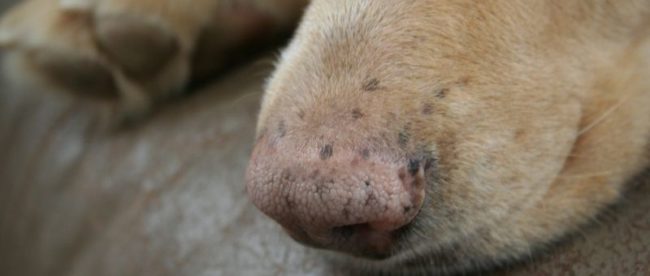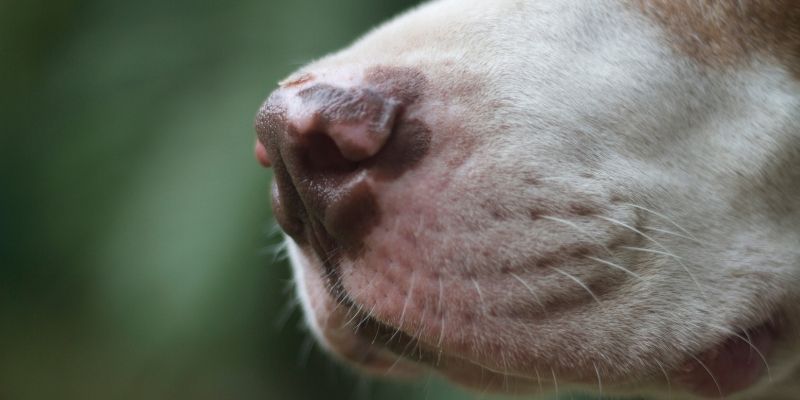Dog Breeds with Pink Noses and How to Take Care of It?

We’ve seen dogs with all kinds of noses—some with pink, some with black. The color of a dog’s nose is left up to its genetics.
Dogs with black noses have a lot of melanin, which gives skin, hair, and eyes their color. And the same way dog eye and hair colors can differ, that’s the same way noses can. That’s why some dogs have pink noses. That just means there is less melanin.
Melanin is a substance that protects against damage from the sun, so it is vital to apply doggy sunblock, especially when dogs with pink noses are outside.
You may notice that puppies have pink noses. That tends to be temporary most times, and by the time they hit between eight and sixteen weeks of age, they darken to black. White puppies are the most common ones with pink noses, though they may still darken.
Some dogs maintain pink noses throughout their lives, though, such as Bull Terriers, Dalmatians, and Heelers. I’m going to talk about dog breeds with pink noses and the different variants that there are.
Do you have a specific question about the subject? Then use the table of contents below to jump to the most relevant section. And you can always go back by clicking on the black arrow in the right bottom corner of the page. Also, please note that some of the links in this article may be affiliate links. For more details, check the Disclosure section at the bottom of the page.
Here's what we'll cover:
Type of Pink Noses in Dogs

Snow Noses
This is when a dog has a pink nose that is caused by colder weather. This is often seen in the Siberian Husky.
Butterfly Noses
Some dogs have a mix of pink and either brown or black on their noses. This is called a butterfly nose and results from genetics, just like with other nose patterns. When a canine has this, you can’t call it a 100% pink nose dog!
Dudley Noses
The Labrador Retriever with a naturally pink nose is known as the Dudley Lab. Labs are born with pink noses that typically turn black as the puppy grows older. But Dudley Labs’ noses remain pink.
White-coated dogs may be more likely to have a pink nose due to a genetic factor resulting in a lack of melanin.
Allergy Noses
Some dogs are allergic to a chemical sometimes found in plastic food dishes. That might also lead to the loss of nose pigmentation result in pink nose dogs.
Vitiligo Noses
Vitiligo is an autoimmune disorder when the body attacks its own tissues. In the case of a pink-nosed dog, the usual black nose of the dog can turn pink because the cells that make the melanin pigment are destroyed. Gradually, the nose turns pink as the melanin cells slowly cease to contain their natural black pigment. This is analogous to the human vitiligo disease, which often causes the natural skin color to fade slowly.

What Breeds of Dogs Have Pink Noses?

Like I earlier told you, most dogs grow out of a baby pink nose. However, some breeds may remain dogs with pink noses all their lives. These include Bull Terriers, Boxers, Dalmatians, and Heelers. Sharpei and Chow Chow may be other examples. Pitbulls are usually referred to as the blue nose or the red nose. They are actually the same breed, and the color of the nose is determined by their bloodlines.
The Dudley nose is when a dog is born with a solid black nose that eventually fades to a pale brown and/or pink nose. In the event of complete depigmentation, the nose can turn pinkish white.
This is not to be confused with the snow nose. This is a different but common condition. The dark pigment on the dog’s nose disappears during the winter months and darkens again in the spring and summer months. Complete depigmentation doesn’t occur. Snow nose is usually seen in Siberian Huskies, Golden Retrievers, Labrador Retrievers, Bernese Mountain Dogs, and a few other breeds.
Pigment loss is typically harmless. However, it might be a sign that your pup is suffering from a condition that needs medical attention. If you have any questions, consult your vet.

How to Care for a Pink Nose?

Similar to pale human skin, pink noses require more sun protection than dark skin or black noses. If you have one of these dog breeds with pink noses or a lighter color, there is a chance that it will get sunburn. This can cause real pain to your dog or even possible risk of cancer. It’s a smart idea to add dog sunscreen lotion when it’s out in the hot sun.
The body is covered by its hair so that it is less likely to sunburn there. However, it is best to stop overexposure and too much time out in the hot sun for light or white-colored dogs.
Applying advanced doggy sunscreen such as the Handy Hound SnoutScreen for a dog with a pink nose during the summer months can prevent painful sunburn on your dog’s sensitive nose.
Besides that, pink noses require the same treatment as darker noses. They should be regularly moisturized with Dog Nose Butter to avert and heal capped and crusty snouts.
Credits: thanks for the cover photo to Canva.

Disclosure: At pawtypooch.com we only mention the products that we’ve researched and considered worthy. But it’s important to note that we are a participant of several affiliate programs, including VigLink, ShareASale, Skimlinks, and Amazon Services LLC Associates Program, an affiliate advertising program designed to provide a mean for us to earn fees by linking to Amazon.com and affiliated sites. As an Amazon Associate pawtypooch.com earns from qualifying purchases. Also, please note that pawtypooch.com does not intend to provide veterinary advice. All published articles are meant for informational purposes only. And this information should not be substituted for professional veterinary consultation.

